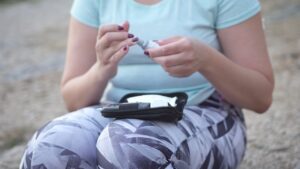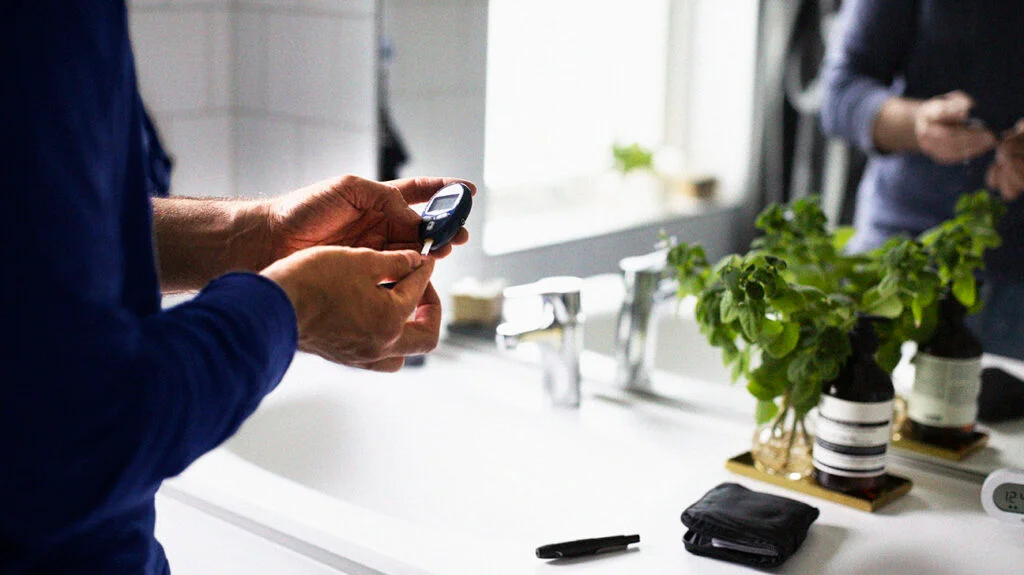Low blood sugar, or hypoglycemia, can be an alarming experience, marked by a range of symptoms such as dizziness, sweating, and confusion. It’s crucial to understand not only how to treat low blood sugar when it occurs but also how to prevent it through lifestyle and dietary adjustments. In this blog, we’ll explore the causes of immediate low blood sugar treatment strategies, and long-term management techniques to help you or your loved ones maintain a healthy blood sugar balance.
Contents
What Happens If Blood Sugar Is Too Low?
 When blood sugar (glucose) levels fall too low, a condition known as hypoglycemia occurs. This can happen for a variety of reasons, such as skipping meals, taking too much insulin or other diabetes medications, exercising more than usual, or drinking alcohol. The brain relies heavily on glucose as its primary source of energy, so low blood sugar levels can affect its functioning.
When blood sugar (glucose) levels fall too low, a condition known as hypoglycemia occurs. This can happen for a variety of reasons, such as skipping meals, taking too much insulin or other diabetes medications, exercising more than usual, or drinking alcohol. The brain relies heavily on glucose as its primary source of energy, so low blood sugar levels can affect its functioning.
Here are some of the consequences and symptoms that can occur when blood sugar is too low:
1. Mild Symptoms
- Sweating
- Trembling or shakiness
- Hunger
- Dizziness or light-headedness
- Palpitations (feeling that your heart is racing)
- Nervousness or anxiety
2. Moderate Symptoms
- Headaches
- Irritability or moodiness
- Confusion and difficulty concentrating
- Blurred vision
- Slurred speech
- Weakness or lack of energy
3. Severe Symptoms
- Seizures or convulsions
- Loss of consciousness
- Severe confusion and disorientation
- Inability to eat or drink
In severe cases, if left untreated, hypoglycemia can lead to coma and can be life-threatening. It’s important for people at risk of hypoglycemia, particularly those with diabetes, to recognize the early symptoms and treat them quickly. For those who are prone to hypoglycemia, carrying some form of sugar or a glucose source at all times is recommended.
What Are The Best Low Blood Sugar Treatments?
 Treating low blood sugar, or hypoglycemia, effectively involves both immediate and longer-term strategies. The immediate goal is to quickly raise your blood sugar to a safe level, while longer-term treatment focuses on preventing future episodes. Here are some of the best low blood sugar treatments:
Treating low blood sugar, or hypoglycemia, effectively involves both immediate and longer-term strategies. The immediate goal is to quickly raise your blood sugar to a safe level, while longer-term treatment focuses on preventing future episodes. Here are some of the best low blood sugar treatments:
Immediate Treatments for Low Blood Sugar
1. 15-15 Rule
- Consume 15 grams of fast-acting carbohydrates.
- Examples include glucose tablets, 4 ounces (1/2 cup) of regular soda or fruit juice, a tablespoon of sugar or honey, or hard candy.
- Wait 15 minutes, then recheck your blood sugar. If it’s still low, consume another 15 grams of carbohydrates.
2. Glucose Tablets/Gels
- Specifically designed to provide a quick, measured dose of glucose.
- Preferred by many due to their convenience and fast-acting nature.
3. Fruit Juices/Sodas
- Quickly absorbed by the body, raising blood sugar levels rapidly.
4. Honey or Sugar
- Easily accessible and quick to absorb.
- Can be taken directly or mixed in water.
Longer-Term Management Strategies
1. Dietary Adjustments
- Eating regular meals and snacks with a balanced mix of carbohydrates, protein, and fats.
- Avoiding high-sugar foods that can lead to blood sugar spikes and subsequent drops.
2. Regular Monitoring
- Regularly monitoring blood sugar levels, especially if you have diabetes or another condition that affects blood sugar.
- Adjusting your meal and medication schedule based on blood sugar readings.
3. Medication Management
- Working with a healthcare provider to adjust any medications that may be causing hypoglycemia.
- Ensuring proper dosing and timing of diabetes medications, especially insulin.
4. Education and Preparedness
- Learning the symptoms of low blood sugar so you can act quickly.
- Always carry a source of fast-acting carbohydrates with you.
5. Exercise Management
- Monitoring blood sugar before, during, and after exercise.
- Adjusting food intake or medication as needed to prevent exercise-induced hypoglycemia.
6. Stress Management
- Stress can affect blood sugar levels, so incorporating stress-reducing activities like yoga or meditation can be helpful.
If hypoglycemia frequently occurs or if severe symptoms develop (such as loss of consciousness or seizures), immediate medical attention is necessary. Managing low blood sugar effectively requires a balance of immediate treatment to raise blood sugar and longer-term strategies to prevent future episodes.
What Are Some Medical Approaches In Low Blood Sugar Treatment?
 Medical approaches to low blood sugar treatment encompass both immediate interventions for acute episodes and long-term strategies to prevent recurrence. These approaches are tailored based on individual health profiles, especially for those with diabetes. Here’s an overview of the various medical strategies:
Medical approaches to low blood sugar treatment encompass both immediate interventions for acute episodes and long-term strategies to prevent recurrence. These approaches are tailored based on individual health profiles, especially for those with diabetes. Here’s an overview of the various medical strategies:
Glucagon Administration
Glucagon is a hormone that raises blood sugar levels by stimulating the liver to release stored glucose. Glucagon injections are used in severe cases of hypoglycemia when the individual is unconscious or unable to consume oral carbohydrates. Family members, caregivers, or trained individuals can administer glucagon injections to quickly raise blood sugar levels and prevent further complications. Glucagon kits are available by prescription and should be readily accessible for those at risk of severe hypoglycemia.
Intravenous Glucose
In emergencies where the individual cannot consume oral carbohydrates or if hypoglycemia is severe, intravenous (IV) administration of glucose may be necessary. Intravenous glucose delivers glucose directly into the bloodstream, rapidly increasing blood sugar levels. This approach is commonly used in hospital settings or by emergency medical personnel when immediate intervention is required to prevent complications associated with severe hypoglycemia, such as seizures or loss of consciousness.
Medication Adjustment
Adjusting the dosage or timing of diabetes medications, particularly insulin, is a key aspect of long-term hypoglycemia management. This may involve working closely with a healthcare provider to fine-tune medication regimens based on factors such as diet, physical activity, and blood sugar patterns. For individuals with diabetes, finding the right balance of insulin or other diabetes medications is essential for maintaining stable blood sugar levels and preventing hypoglycemia.
Continuous Glucose Monitoring (CGM)
Continuous glucose monitoring (CGM) systems provide real-time data on blood glucose levels, allowing individuals to track trends and make informed decisions about managing their diabetes. CGM devices consist of a sensor that is placed under the skin to measure glucose levels continuously, providing valuable insights into blood sugar patterns throughout the day and night. CGM technology can help individuals with diabetes identify factors that contribute to hypoglycemia, such as insulin dosing, diet, and physical activity, and make adjustments to minimize the risk of low blood sugar episodes.
Insulin Pump Therapy
Insulin pump therapy, also known as continuous subcutaneous insulin infusion (CSII), is a method of insulin delivery that provides a continuous infusion of insulin throughout the day and night. Insulin pumps deliver rapid-acting insulin through a small catheter inserted under the skin, allowing for precise adjustments in insulin dosing based on factors such as meal intake, physical activity, and blood sugar levels.
Regular Medical Follow-Up
Regular check-ups with healthcare providers are essential for monitoring blood sugar control, identifying any underlying issues contributing to hypoglycemia, and adjusting treatment plans as needed. Healthcare providers may perform regular blood tests to assess blood sugar levels, review medication regimens, and evaluate overall health and well-being. By staying engaged with healthcare providers and participating in ongoing care, individuals with diabetes can receive the support and guidance they need.
Conclusion
In conclusion, low blood sugar treatments require a combination of immediate actions and long-term strategies. Immediate treatment options, such as consuming fast-acting carbohydrates or administering glucagon in emergencies, can quickly raise blood sugar levels and alleviate symptoms. For long-term management, adjustments to medication, continuous glucose monitoring, insulin pump therapy, and regular medical follow-up are essential.
By working closely with healthcare providers and adopting a proactive approach to self-care, individuals can better control their blood sugar levels and improve overall health and well-being. Do you want to get rid of diabetes? Join our online diabetes treatment program and reverse Diabetes naturally through lifestyle changes such as a Personalized Diet plan, Exercise, Yoga, dieticians, and health coaches.

